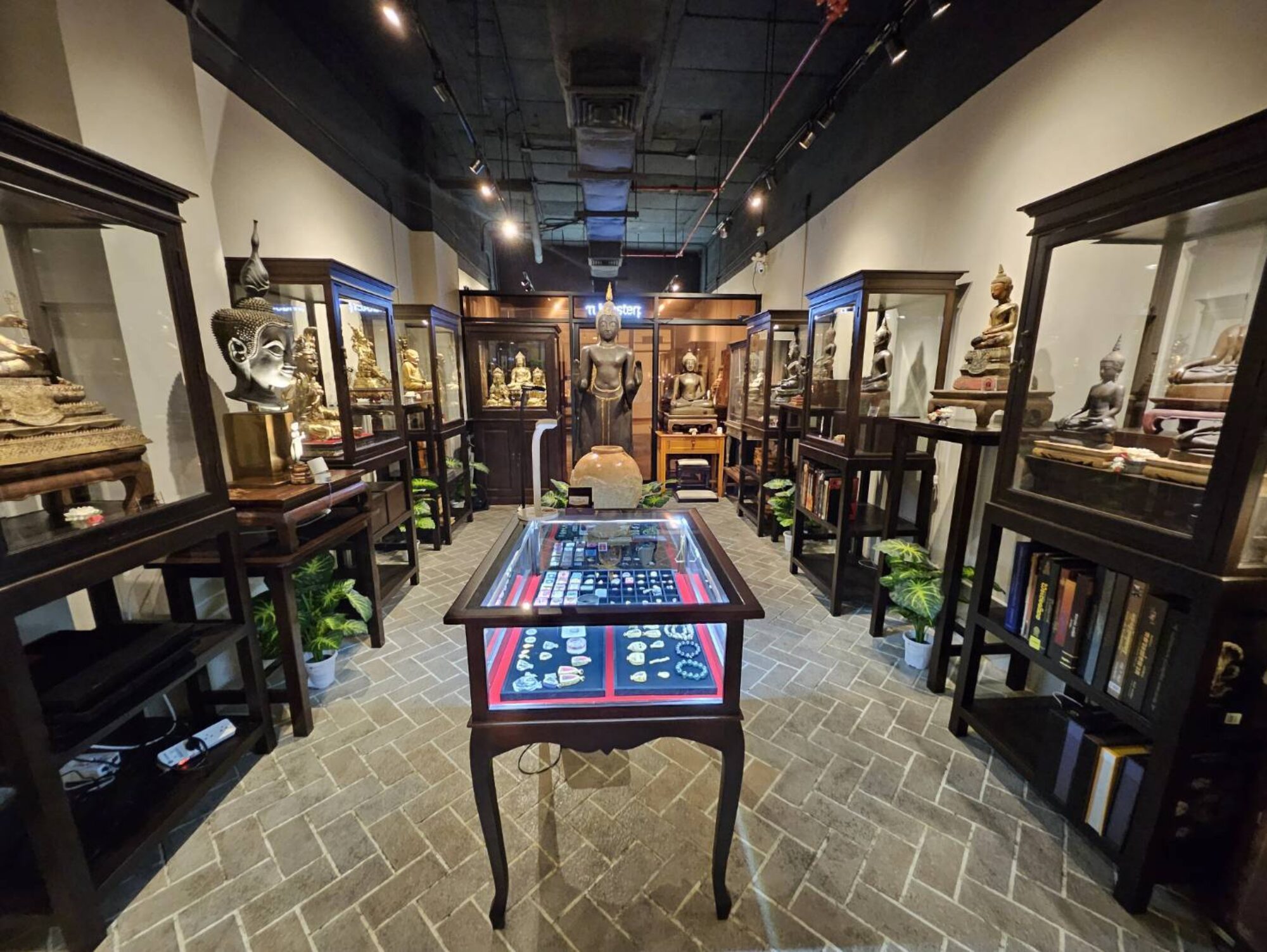
พระพุทธรูปสุโขทัย
ประวัติความเป็นมา
พระพุทธรูปสุโขทัยเป็นผลงานศิลปะที่เจริญรุ่งเรืองในช่วงพุทธศตวรรษที่ 19–20 (ประมาณ 700 ปีที่ผ่านมา) ในสมัยกรุงสุโขทัย ซึ่งเป็นราชธานีแห่งแรกของไทย ศิลปะสุโขทัยเป็นที่ยอมรับว่าเป็นยุคทองของศิลปะไทย มีเอกลักษณ์เฉพาะตัวที่งดงามและละเอียดอ่อน
การสร้างพระพุทธรูปในสมัยนี้ได้รับอิทธิพลจากศาสนาพุทธเถรวาท ซึ่งมีการเน้นรูปแบบที่สื่อถึงความสงบ สันติ และสมาธิ โดยสะท้อนถึงความศรัทธาและความปรารถนาสู่การตรัสรู้
ลักษณะเด่นของพระพุทธรูปสุโขทัย
- พระพักตร์ (ใบหน้า): รูปทรงไข่ อ่อนโยนและสงบสุข ดูเมตตา
- พระเกตุมาลา (เปลวรัศมี): สูงแหลมเป็นเปลวไฟ สื่อถึงปัญญาและบารมี
- พระขนง (คิ้ว): โค้งได้รูปคล้ายปีกกา เพิ่มความงามและความสง่างาม
- พระเนตร (ตา): ตาเล็กเหลือบต่ำ สื่อถึงสมาธิและความสงบนิ่ง
- พระโอษฐ์ (ปาก): เล็กและโค้งเล็กน้อย สื่อถึงความอ่อนโยนและเมตตา
- พระวรกาย (ลำตัว): อ่อนช้อย มีสัดส่วนที่สมบูรณ์แบบและงดงาม
- อิริยาบถ: ปางมารวิชัย (ปางชนะมาร) นั่งขัดสมาธิ สื่อถึงการเอาชนะกิเลสและการตรัสรู้
คุณค่าและความเหมาะสมในการสะสม
- คุณค่าทางประวัติศาสตร์: พระพุทธรูปสุโขทัยสะท้อนถึงยุคทองของศิลปะไทยและศรัทธาในพุทธศาสนา
- ความหายาก: เป็นงานศิลป์ที่มีอายุยาวนานและเป็นที่ต้องการของนักสะสม
- คุณค่าทางจิตใจ: ถือเป็นวัตถุมงคลที่ช่วยเสริมสิริมงคลและความเจริญรุ่งเรืองแก่ผู้ครอบครอง
- ความงามทางศิลปะ: งานแกะสลักประณีต สะท้อนถึงฝีมือเชิงช่างที่ยอดเยี่ยม
- การลงทุนระยะยาว: พระพุทธรูปสุโขทัยเป็นของสะสมล้ำค่าที่มีมูลค่าเพิ่มขึ้นเรื่อย ๆ ตามเวลา
ข้อเสนอแนะในการสะสม
พระพุทธรูปสุโขทัยเหมาะสำหรับผู้ที่ต้องการสะสมงานศิลปะโบราณเพื่ออนุรักษ์วัฒนธรรมไทยและเสริมสิริมงคลในบ้านเรือนหรือธุรกิจ ควรจัดแสดงในตู้กระจกเพื่อป้องกันความเสียหายและรักษาสภาพดั้งเดิมให้คงอยู่ต่อไป
ตำนานพระพุทธรูปสุโขทัยปางมารวิชัย
ณ อาณาจักรสุโขทัยอันรุ่งเรือง พระมหากษัตริย์ผู้เปี่ยมด้วยศรัทธาในพระพุทธศาสนาได้มีพระราชดำริให้สร้างพระพุทธรูปศักดิ์สิทธิ์ เพื่อเป็นศูนย์รวมใจและเป็นตัวแทนแห่งพระธรรมคำสอน ด้วยแรงศรัทธาและความมุ่งมั่น ช่างฝีมือผู้เชี่ยวชาญได้ร่วมกันสร้างพระพุทธรูปปางมารวิชัยที่เปี่ยมด้วยความงดงามและพลังแห่งศาสนา
ตำนานการสร้างพระพุทธรูป
เล่าว่า ในขณะหล่อองค์พระพุทธรูป ได้มีแสงสว่างเจิดจ้าปรากฏขึ้นจากท้องฟ้าและมีเสียงสวดมนต์ดังกังวานโดยไร้ที่มา ชาวบ้านต่างพากันกราบไหว้และเชื่อว่านี่คือสัญญาณจากเทพยดาที่อำนวยพรให้องค์พระเต็มเปี่ยมด้วยพลังแห่งบุญบารมี
มีเรื่องเล่าว่า ในวันทำพิธีเบิกเนตร องค์พระได้เปล่งแสงเรืองรองออกจากพระพักตร์ ดุจเป็นสัญลักษณ์แห่งการปกป้องและนำทางสู่แสงสว่างทางจิตวิญญาณ นับแต่นั้นมา พระพุทธรูปองค์นี้ได้รับการเคารพบูชาในฐานะพระพุทธรูปศักดิ์สิทธิ์แห่งชัยชนะเหนืออุปสรรค
ศิลปะและความศรัทธา
พระพุทธรูปองค์นี้มีเอกลักษณ์ในศิลปะสุโขทัย พระพักตร์อ่อนโยนเปี่ยมเมตตา พระวรกายอ่อนช้อยและสง่างาม แสดงถึงความสมดุลและสงบสุข สื่อถึงปัญญาและความเมตตาของพระพุทธเจ้า
ผู้ศรัทธาเชื่อว่า การบูชาพระพุทธรูปปางมารวิชัยจะช่วยเสริมสร้างกำลังใจ ให้สามารถเอาชนะอุปสรรคและความยากลำบากในชีวิตได้ ด้วยพลังแห่งบุญและความมุ่งมั่น
ปาฏิหาริย์และความศรัทธา
เล่าขานกันว่าผู้ที่มาขอพรต่อองค์พระจะได้รับความสำเร็จทั้งด้านการงานและชีวิต โดยเฉพาะการปัดเป่าสิ่งชั่วร้าย โรคภัย และอุปสรรคต่าง ๆ มีหลายเหตุการณ์ที่ผู้คนมาขอพรแล้วหายป่วยหรือผ่านพ้นวิกฤตในชีวิตไปได้อย่างอัศจรรย์
นอกจากนี้ ยังมีตำนานเล่าถึงพ่อค้าเดินทางไกลที่หลงทางกลางป่า ได้อธิษฐานขอให้พบทางออกด้วยการสวดมนต์ต่อพระพุทธรูปองค์นี้ ทันใดนั้น แสงสว่างไสวก็ปรากฏขึ้นนำทางเขากลับบ้านอย่างปลอดภัย
ข้อคิดจากตำนาน
พระพุทธรูปองค์นี้เป็นสัญลักษณ์แห่งความศรัทธา ความมุ่งมั่น และความสงบทางจิตใจ ผู้คนเชื่อว่าหากมีจิตใจที่บริสุทธิ์และปฏิบัติตามคำสอนของพระพุทธเจ้า ชีวิตจะพบแต่ความสุข ความเจริญ และสามารถเอาชนะความทุกข์ได้เสมอ
ด้วยเหตุนี้ พระพุทธรูปองค์นี้จึงเป็นศูนย์รวมของศรัทธาและเป็นที่เคารพสักการะอย่างลึกซึ้งของพุทธศาสนิกชนทั้งหลาย
Sukhothai Buddha Image
Historical Background
The Sukhothai Buddha image is an artistic masterpiece that flourished during the 19th–20th Buddhist centuries (approximately 700 years ago) in the Sukhothai period, which was the first capital of Thailand. Sukhothai art is widely regarded as the golden age of Thai art, characterized by its elegance, refinement, and unique style.
Buddha statues from this era reflect the influence of Theravada Buddhism, emphasizing peace, serenity, and meditation. They embody the devotion and aspiration for enlightenment prevalent during that time.
Distinctive Features of the Sukhothai Buddha Image
- Facial Features: Oval-shaped face, gentle and serene, radiating kindness.
- Usnisa (Flame-like Finial): Tall and flame-shaped, symbolizing wisdom and spiritual radiance.
- Eyebrows: Gracefully arched like bird wings, enhancing elegance.
- Eyes: Small and downcast, reflecting deep meditation and tranquility.
- Lips: Small and gently curved, expressing compassion and calmness.
- Body Proportions: Graceful and well-balanced, portraying harmony and beauty.
- Posture: Depicted in the “Subduing Mara” gesture (Bhumisparsha Mudra), symbolizing victory over temptations and the attainment of enlightenment.
Value and Suitability for Collecting
- Historical Significance: Sukhothai Buddha images represent the golden age of Thai art and devotion to Buddhism.
- Rarity: As ancient artifacts, these statues are rare and highly sought after by collectors.
- Spiritual Value: Considered sacred objects believed to bring blessings, prosperity, and protection.
- Artistic Beauty: Renowned for their delicate carvings and flawless proportions, showcasing the exceptional craftsmanship of the period.
- Investment Potential: Sukhothai Buddha images are highly valued collectibles, with increasing worth over time.
Collecting Recommendations
Sukhothai Buddha images are ideal for collectors who appreciate ancient art and want to preserve Thai cultural heritage. They also serve as auspicious decorations for homes and businesses. It is recommended to display them in glass cases to maintain their original condition and protect their artistic beauty.
Legend of Sukhothai Buddha Image in Mara-Vijaya Posture
In the glorious Sukhothai Kingdom, a devout Buddhist king had the idea to create a sacred Buddha image to be the center of the heart and a representative of the Dharma teachings. With faith and determination, skilled craftsmen worked together to create a Buddha image in Mara-Vijaya posture that is full of beauty and religious power.
Legend of the Buddha Image Creation
It is said that while casting the Buddha image, a bright light appeared from the sky and the sound of chanting resounded out of nowhere. The villagers all bowed down and believed that this was a sign from the gods that blessed the Buddha image with the power of merit.
It is said that on the day of the eye-opening ceremony, the Buddha image emitted a bright light from its face, as if it were a symbol of protection and guidance to spiritual light. Since then, this Buddha image has been worshipped as a sacred Buddha image of victory over obstacles.
Art and Faith
This Buddha image is unique in Sukhothai art. Its gentle face is full of compassion. Its body is graceful and elegant, showing balance and peace, conveying the wisdom and compassion of the Buddha.
Devotees believe that worshiping the Mara-Vijaya Buddha image will help boost their morale and help them overcome obstacles and hardships in life with the power of merit and determination.
Miracles and Faith
It is said that those who come to pray to the Buddha will be successful in both their careers and lives, especially in warding off evil, illnesses, and obstacles. There have been many incidents where people who come to pray for blessings miraculously recovered from illnesses or passed crises in their lives.
In addition, there is a legend about a traveling merchant who got lost in the middle of the forest and prayed to find a way out by praying to this Buddha image. Suddenly, a bright light appeared to guide him home safely.
Moral of the Legend
This Buddha image is a symbol of faith, determination, and peace of mind. People believe that if you have a pure mind and follow the Buddha’s teachings, your life will be happy, prosperous, and you will always be able to overcome suffering.
For this reason, this Buddha image is the center of faith and is deeply respected by all Buddhists.
素可泰佛像
历史背景
素可泰佛像是泰国素可泰时期(佛历19–20世纪,约700年前)的艺术瑰宝。素可泰是泰国的第一个首都,这一时期被认为是泰国艺术的黄金时代,以其独特、精致和优雅的风格闻名于世。
该时期的佛像受到上座部佛教的影响,强调和平、宁静和冥想,体现了当时人们对佛教信仰和追求觉悟的虔诚态度。
素可泰佛像的独特特征
- 面部特征: 蛋形脸庞,温和宁静,散发慈祥之感。
- 顶髻(火焰形冠饰): 高耸呈火焰状,象征智慧与光辉。
- 眉毛: 弯曲如鸟翼,增添优雅感。
- 眼睛: 微垂小巧,表现出深邃冥想的神态。
- 嘴唇: 小而微弯,传达慈悲与安详。
- 身体比例: 线条优美,比例协调,展现和谐之美。
- 姿势: 降魔印(触地印),象征战胜诱惑和成就觉悟。
收藏价值与适合收藏的理由
- 历史价值: 素可泰佛像代表泰国艺术的黄金时代,展现了佛教信仰的虔诚与文化传承。
- 稀有性: 作为古代文物,这些佛像稀缺且备受收藏家追捧。
- 精神价值: 被视为神圣物品,相信能带来祝福、繁荣和保护。
- 艺术美感: 雕刻工艺精湛,比例完美,展现当时匠人的高超技艺。
- 投资潜力: 素可泰佛像是增值空间较大的收藏品,在古董市场中极具价值。
收藏建议
素可泰佛像非常适合收藏古代佛教艺术爱好者,同时也是家庭或商业场所的吉祥装饰品。建议将其展示于玻璃柜中,以保持原始状态,保护其艺术美感和收藏价值。
素可泰佛像马拉维猜姿势的传说
在辉煌的素可泰王国国王对佛教充满信心,萌生了建造一尊神圣佛像的想法。成为佛法教义的心灵中心和代表凭着信念和决心专家工匠们共同打造了一座充满美丽和宗教力量的马拉维贾亚佛像。
佛像诞生的传说
铸造佛像时说道一道璀璨的光芒从天而降,圣歌之声不知从何而来。村民们顶礼膜拜,认为这是神灵加持佛陀功德力量的征兆。
有这样一个故事开幕式当天佛陀的脸上放射出灿烂的光芒。作为保护和引导心灵光明的象征,从此被尊为战胜障碍的神圣佛像。
艺术与信仰
这尊佛像在素可泰艺术中是独一无二的。他的脸上充满了慈悲和温柔。他的身体温柔而优雅。代表平衡与和平。它代表了佛陀的智慧和慈悲。
信徒相信以摩罗姿势供奉佛像,有助于增强士气。能够克服生活中的障碍和困难凭借功德和决心的力量
奇迹与信仰
据说,来拜佛的人都会事业有成、生活顺利。特别是为了辟邪、疾病和各种障碍,人们前来祈祷并奇迹般地痊愈或克服了生活中的危机。
还有一个关于一位旅行商人在森林中迷路的传说。他向这尊佛像祈求一条出路,突然一道明亮的光芒出现,指引他平安回家。
来自传奇的思考
这尊佛像是信仰、决心和内心平静的象征。人们相信,只要有一颗清净的心,遵循佛陀的教诲,生活只会找到幸福、繁荣,你永远能够克服痛苦。
因此,这尊佛像是信仰的化身,深受广大佛教徒的崇敬。
